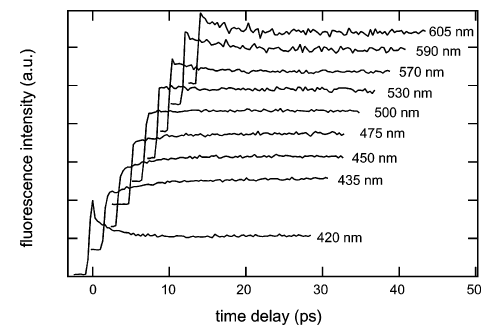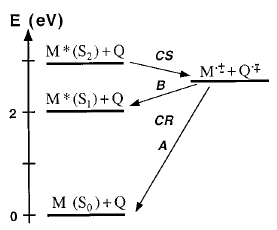-
Ultrafast spectroscopy on bimolecular photoinduced electron transfer reactions
A. Morandeira, A. Fürstenberg, S. Pagès, B. Lang and E. Vauthey
The Spectrum, 17 (4) (2004), p14-19


unige:3248 | Article PDF
|
|
 |
|||||||
The electron transfer quenching dynamics of excited perylene and cyanoperylene in various donating solvents has been investigated by using ultrafast fluorescence up-conversion and multiplex transient grating. The strongly nonexponential fluorescence decays have been analyzed by using the orientational model described in the first article of this series (J. Phys. Chem. A 2003, 107, 5375). It appears that the solvent dependence of the quenching dynamics is strongly connected to the number of surrounding donor molecules enabling ultrafast electron transfer. This number depends mainly on the driving force for electron transfer, on steric interactions, and on the occurrence of dipole−dipole interactions with the acceptor. The quenching product is an exciplex with a strong charge-transfer character. The complicated wavelength dependence of the fluorescence dynamics in the exciplex region, as well as the spectral dynamics observed in the transient grating data, is attributed to dipolar solvation, which leads to an increase of the charge-transfer character of the exciplex. The strong donor dependence of the exciplex lifetime is very similar to that reported earlier for the charge recombination time of geminate ion pairs in acetonitrile, and can be rationalized in terms of different intramolecular reorganization energies and electronic coupling constants. | ||||||||
|
||||||||
An investigation of the ultrafast excited state dynamics of triporphyrin and hexaporphyrin arrays consisting of covalently linked Zn tetraphenylporphine (ZnTPP) and free base tetraphenylporphine (FbTPP) units is reported. The interchromophoric distance in the hexamers is of the order of 13 Å, while it varies from 26 to 70 Å in the trimers. These arrays exhibit several features that differ substantially from those of the monomeric units: a broadening of the Soret band, a shortening of the S2 lifetime of the ZnTPP chromophores, and additional ultrafast decay components of the S1 fluorescence. In the hexaporphyrin arrays, most of these features are attributed to the presence of excitonic states that result from the strong coupling between the Bx,y transition dipoles. The time constants for S1 energy transfer between ZnTPP chromophores as well as between ZnTPP and FbTPP moieties, deduced from anisotropic and isotropic time-resolved fluorescence measurements, were found to be of the order of a few tens of picoseconds. Moreover, back energy transfer from the FbTPP to ZnTPP units is also observed. At high to moderate excitation intensity, S1−S1 annihilation becomes an important decay mechanism of the excited state population of the hexaporphyrins. In the triporphyrins, the differences relative to the monomer are ascribed to the interaction with the phenylacetylene linkers, which lifts the degeneracy of the S2 states. S2 and S1 energy transfer were found to take place in the triporphyrin with the shortest linker only. In the other triporphyrins, an efficient energy transfer from the linker to the porphyrin units was observed. | ||||||||
 |
|
|||||||
The electron transfer (ET) quenching dynamics of excited perylene (Pe), cyanoperylene (PeCN), methanolperylene (PeOH), and methylperylene (PeMe) in N,N-dimethylaniline (DMA) has been investigated using ultrafast fluorescence up-conversion. Measurements of the rotational dynamics of PeCN and PeMe in nonpolar and polar inert solvents using optically heterodyned polarization spectroscopy are also presented. The fluorescence decay in DMA is strongly nonexponential and about 10 times faster with PeCN than with the other electron acceptors. The quenching dynamics has been analyzed with a model distinguishing three types of donor molecules surrounding the acceptor: those with optimal orientation for ET and those requiring orientational or translational diffusion prior to ET. According to this model, which can account for the whole fluorescence decay, the faster quenching dynamics of PeCN is not due to a larger ET rate constant, but to a larger number of donor molecules, typically three to four, with an optimal orientation. This is explained by the effect of dipole−dipole interaction between PeCN and the donor molecules, which favors mutual orientations with a large electronic coupling. With the other acceptors, this interaction is either not present or does not lead to ET active geometries. The occurrence of this interaction is substantiated by the rotational dynamics measurements. | ||||||||
|
||||||||
Several aspects of ultrafast photochemistry in the condensed phase are discussed and illustrated by three examples from our laboratory. | ||||||||
|
 |
|||||||
The dynamics of charge recombination (CR) of ion pairs formed upon electron-transfer quenching of Zn tetraphenylporphine (ZnTPP) in the S2Â state has been investigated by fluorescence upconversion. These ion pairs have two possible CR pathways:Â (A) a highly exergonic CR to the neutral ground state and (B) a moderately exergonic CR leading to the formation of ZnTPP in the S1Â state. Upon addition of quencher, the S2Â fluorescence decreases considerably, while the S1Â fluorescence is unaffected, indicating unambiguously that CR occurs via path B. A large fraction of the S2Â fluorescence quenching occurs in less than 100 fs. CR to the S1Â state of ZnTPP takes place with time constants around 400 fs. | ||||||||
|
|